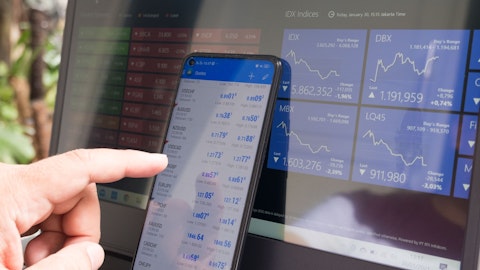Joe Payne: No, that’s a good question. First of all, I can speak to what’s readily available in 2022 over 82 million messenger RNA COVID vaccine boosters were distributed in Japan. That number is not tightly understood for 2023, but it was a significant number, as you can appreciate. For 2024, we now, as we touched on just moments ago, the Japanese government is — has indicated and communicated the clear recommendation that the elderly get two booster shots a year and the elderly population is 32 million to 36 million in Japan. So it’s a significant number of people. And it was very good to hear that the government of Japan is going to be providing these vaccinations to the elderly free of charge. So speculating what that — how that impacts the market is going to be difficult for me to do, more appropriate for analysts on this call to do that.
Jan Hughes: Thanks for the information. In prior years in Japan, where the average booster doses per person under two?
Joe Payne: Japan is well-known to have a high rate of vaccinations per person. Many would say that they have the highest rate of vaccinations for any country in the world, especially relative to US and Europe. So they have a high prevalence for getting vaccinated and the elderly is even higher, so a very high rate of vaccination. How we project this into 2024? I think it’s reasonable to expect a very high percentage of these people will fill out these cards that they receive in the mail, set up times to go to the clinic to get their free vaccination. But what number that is, it would be inappropriate for me to guide on.
Jan Hughes: Sorry, Joe. My question was the prior recommendation was the default number of boosters a person get per year, is that not twice a year? Was that less a year?
Joe Payne: I don’t know what the previous recommendation was. All I can comment on is what’s clearly communicated on the MHLW website, which is two boosters annually for everyone over 65 in Japan.
Jan Hughes: Got it. Okay. Thank you. And on the CF program, the Phase 1b portion, those patients got two administrations of ARCT-032. I was wondering what’s the interval between those two administrations? And also, I think you mentioned on the call that FEV1 along clearance deemed measures are being collected, perhaps mostly for — from a safety standpoint. But the question is, will you be presenting those data at the readout? Thank you.
Joe Payne: Well, the first comment was the primary purpose of this Phase 1b data is to ascertain safety and tolerability. We will be looking at severe adverse events and also more specifically side effects associated with the lung as this is a CF program, and there’s increased sensitivity to lung related side effects like coughing, et cetera. So that’s where we’re going to be more focused on in terms of externally communicating Phase 1b interim data, a severe adverse events and more lung centric side effects and just summarizing the safety and tolerability in a spectrum, a small spectrum of a relatively small group of CF patients. The other parameters are secondary or even exploratory in nature. We’re not expecting in a small cohort like this, where many of these people are already on CFTR modulators that we’ll see some efficacy readouts or anything like that.
But we definitely will have an opportunity to present that data, the Phase 1b data later this year when we have a better idea, which conference.
Jan Hughes: Great. And the building interval?
Joe Payne: Thank you. The dosing interval we have not shared publicly. This is a competitive environment. We’ve made it very clear that these are two administrations. They’re inhaled. We haven’t disclosed the dose levels, if they’re the same or different, and how far apart they are. We had considerable learning’s from the 32 subjects of data and the four cohorts evaluated in Phase 1, so we wanted to — and we’ve applied those learning’s to the design of this Phase 1b trial, and we just wanted to keep those cards close to our chest at this time.
Jan Hughes : Got it. Thank you.
Operator: Our next question comes from Yigal Nochomovitz with Citi. Please proceed with your question.
Unidentified Analyst: Hi. This is Amin on for Yigal. Thank you for taking our questions. I have two related to cystic fibrosis. First, on the upcoming CF readout, should we expect, if you can clarify, should we expect any data from the HALC volunteers there as well? And except long capacity and lung function, have you took bronchi biopsy to look at the CFTR expressions there? Also, what have you seen so far in the healthy volunteers that’s suggesting a better tolerability of this drug versus the prior mRNA studies?
Joe Payne: Yeah. Yeah, the CF readout is simply going to be focused on severe adverse events or any sort of adverse events associated with the lung, like I just mentioned. I don’t think we’re going to be sharing any outside data from that. With respect to samples being directly taken from the lung? Pad, do you have a comment there? There’s nothing that we’re doing, but anything to comment?




